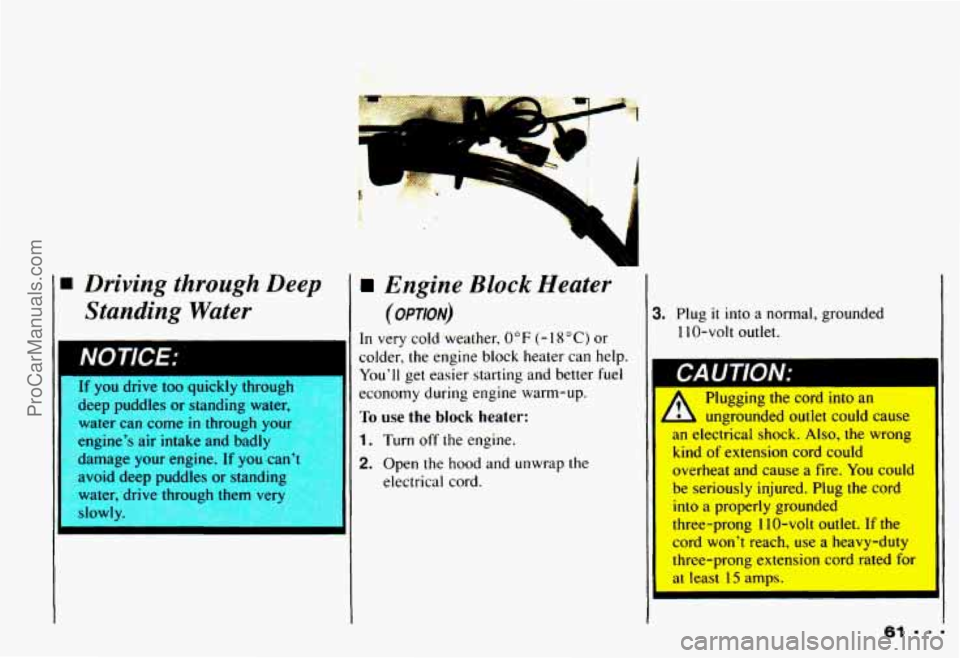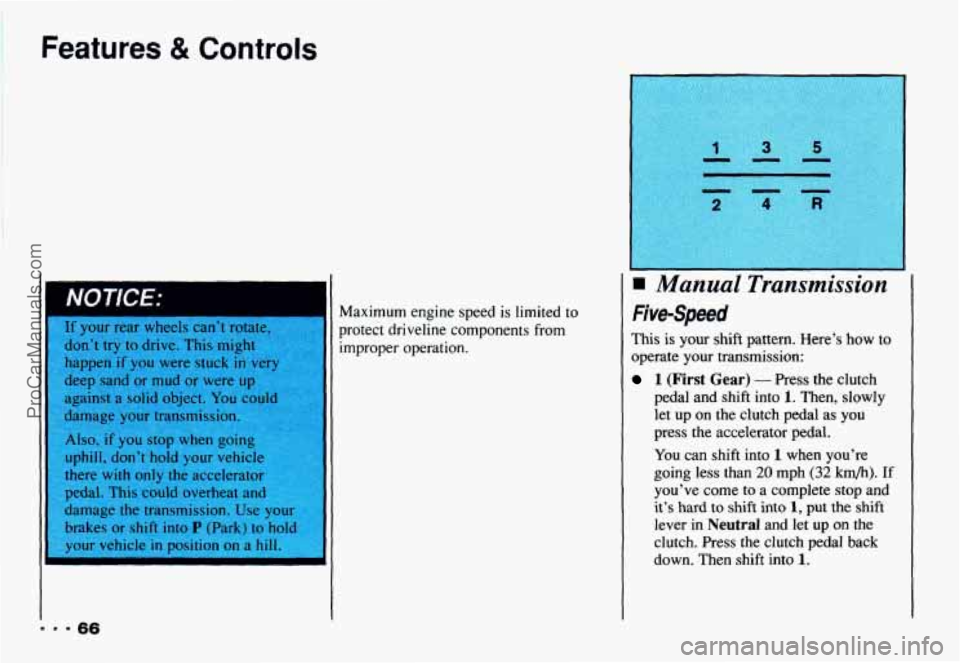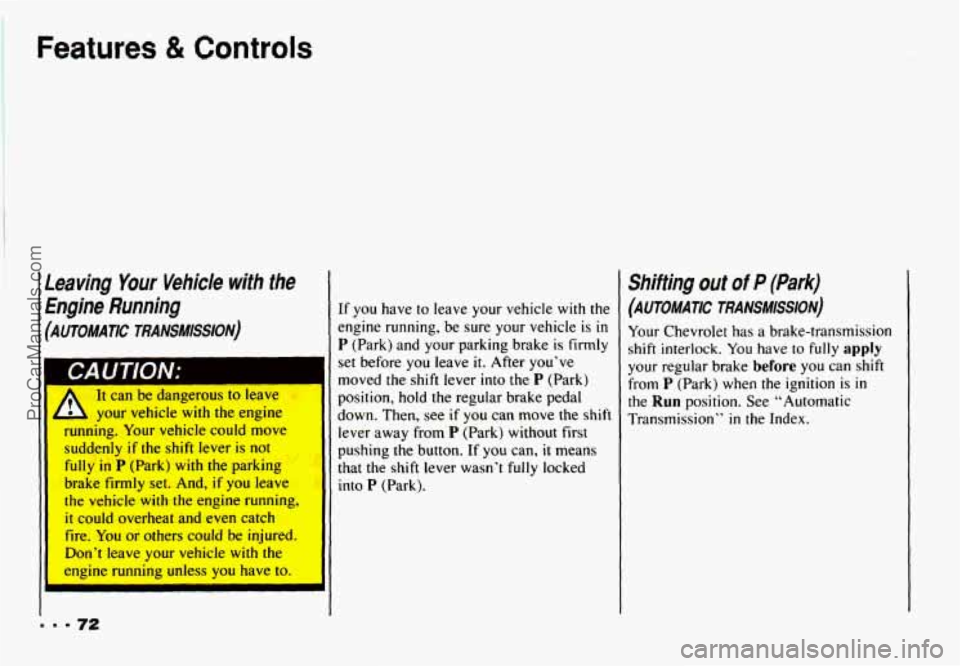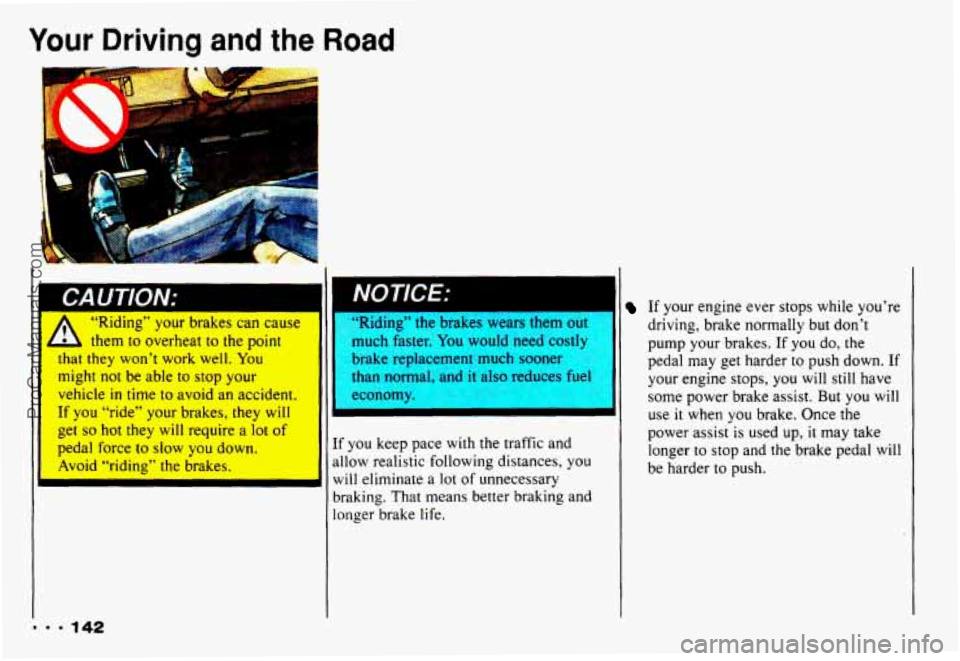1993 CHEVROLET CAMARO engine overheat
[x] Cancel search: engine overheatPage 8 of 358

How to Use This Manual
How to Use This
Manual
Many people read their owner’s manual
from beginning to end when they first
receive their new vehicle. This will help
you learn about the features and controls
for your vehicle. In this manual, you’ll
find that pictures and words work
together to explain things quickly.
Index: A good place to look for what
you need is
the Index in back of the
manual. It’s an alphabetical list of all
that’s
in the manual, and the page
number where you’ll find it.
Parts 1-8: Each part of this manual
begins with a brief list of its contents,
so
you can often find at a glance if a part
contains the information you want.
How to Use This Manual
This part tells you how to use your
manual and includes safety and vehicle
damage warnings and symbols.
Part 1: Seats & Safety Belts
This part tells you how to use your seats
and safety belts properly.
Part 2: Features & Controls
This part explains how to start and
operate your Chevrolet.
Part 3: Comfort Controls & Audio
Systems
This part tells you how to adjust the
ventilation and comfort controls and
how to operate your sound system.
Part 4: Your Driving and the Road
Here you’ll find helpful information and
tips about the road and how to drive
under different conditions.
Part 5: Problems on the Road
This part tells you what to do if you
have a problem while driving, such as a
flat tire or engine overheating.
Part 6: Service & Appearance Care
Here the manual tells you how to keep
your Chevrolet running properly and
looking
good.
Part 7: Maintenance Schedule
This part tells when to perform vehicle
maintenance and what fluids and
lubricants to use.
ProCarManuals.com
Page 65 of 358

Driving through Deep Standing
Water
NOTiCE:
[f you drive too quickly throul
deep puddles or standing wt :r,
water can come
in through your
engine’s air intake and badly
damage your engine.
If you can’t
avoid deep puddle< nr standing
water, drive throul them very
slowly
Engine Block Heater
(OPTION)
In very cold weather, 0 OF (- 1 8 “C) or
colder, the engine block heater can help.
You’ll get easier starting and better fuel
economy during engine warm-up.
To use the block heater:
1. Turn off the engine.
2. Open the hood and unwrap the
electrical cord.
3. Plug it into a normal, grounded
1 10-volt outlet.
CA UTiON:
A
Plugging the cord into an
ungrounded outlet could cause
I
an electrical shock. Also, the wrong
kind of extension cord could
overheat and cause a fire. You could
be seriously injured. Plug the cord into a properly grounded
three-prong
1 10-volt outlet. If the
cord won’t reach, use a heavy-duty
three-prong extension cord rated
for
at least 15 amps.
ProCarManuals.com
Page 70 of 358

Features & Controls
r
If your rear wheels can’t rotat
don’t try to drive.
This might
happen if you were stuck
in v
deep sand or mud or were up
, , against a solid object. You
damage your transmission
Also, if you stop when goi
uphill, don’t hold your vehi
there
with only the accelerat
pedal. This could overheat an
damage the transmission.
Use your
brakes or shift into
P (Park) to hold
9.966
Maximum engine speed is limited to
protect driveline components from
improper operation.
Manual Transmission
Five-Speed
This is your shift pattern. Here’s how to
operate your transmission:
1 (First Gear) - Press the clutch
pedal and shift into
1. Then, slowly
let up on the clutch pedal as you
press the accelerator pedal.
You can shift into
1 when you’re
going less than
20 mph (32 km/h). If
you’ve come to a complete stop and
it’s hard to shift into
1, put the shift
lever in
Neutral and let up on the
clutch.
Press the clutch pedal back
down. Then shift into
1.
ProCarManuals.com
Page 76 of 358

Features & Controls
.eaving Your Vehicle with the
rngine Running
AUTOMATIC TRANSMISSION)
A It can be dangerous to leave
,A your vehicle with the engine
running. Your vehicle could move
suddenly
if the shift lever is not
fully in P (Park) with the parking
brake firmly set. And, if you leave
the vehicle with the engine running,
it could overheat and even catch
fire. You or others could be injured.
Don’t leave your vehicle
with the
I I engine running unless you have to.
If you have to leave your vehicle with the
engine running, be sure your vehicle
is in
P (Park) and your parking brake is firmly
set before you leave it. After you’ve
moved the shift lever into the
P (Park)
position, hold the regular brake pedal
down. Then, see
if you can move the shift
lever away from
P (Park) without first
pushing the button. If you can, it means
that the shift lever wasn’t fully locked
into
P (Park).
Shifting out of P (Park)
(AUTOMATIC TRANSMISSION)
Your Chevrolet has a brake-transmission
shift interlock. You have
to fully apply
your regular brake before you can shift
from
P (Park) when the ignition is in
the Run position. See “Automatic
Transmission”
in the Index.
ProCarManuals.com
Page 106 of 358

Features 8t Controls
f
I
I
. ’ 102
If the light stays on or comes on when
you’re driving, stop
as soon as possible
and turn the key off. Then start the engine
to reset the system. If the light still stays
on, or comes on again while you’re
driving, your Chevrolet needs service.
Unless the regular brake system warning
light is also on, you
will still have brakes,
but not anti-lock brakes. If the regular
brake system warning
light is also on, see
“Brake System Warning Light” earlier
in
this part. When your anti-lock system is working,
the message
LOW TRAC will appear on
your instrument cluster. This means that
slippery road conditions may exist. Adjust
your driving accordingly. The light
will
stay on for about four seconds after the
ABS stops working. The
LOW TRAC
light also comes on during engine starting
as
a bulb check.
Engine Coolant Temperature Gage
This gage shows the engine coolant
temperature.
If the gage pointer moves
into the red area, your engine is
too hot!
It means that your engine coolant has
overheated. If you have been operating
your vehicle under normal driving
conditions, you should
pull off the road,
stop your vehicle and
turn off the engine
as soon as possible.
HOT COOLANT CAN BURN YOU
BADLY!
In ”Problerns on the Road,” this manual
shows
what to do. See “Engine
Overheating”
in the Index.
ProCarManuals.com
Page 109 of 358

Check Gages Light
This light will come on briefly when you
are starting the engine.
If the light comes
on and stays
on while you are driving.
check your gages
to see if they are in the
warning areas.
Low Oil Light
This light should come on while you are
starting your engine.
If the light doesn’t
come on. have
it repaired. If the light
comes on while starting your engine and
stays on. your engine
oil level may be too
low. You may need to add oil. See the
Index under “Engine
Oil.“
Low Coolant Light (V8 Engine)
This light should come on while you are
starting your engine.
If the light doesn’t
come on, have
it repaired. The light also
comes on when the coolant
in your
radiator is low.
You may need to add
coolant. See
the Index under “Engine
Coolant.“
.. Drtvlng wilt Lllr uw vv wwvuIIA I’
light on could cause your Chevrolet tc
overheat. See “Engine Overheating”
in the Index. Your Chevrolet could be
damaged, and
it wouldn’t be covered
by your warranty.
ProCarManuals.com
Page 146 of 358

Your Driving and the Road
I
CAUTION: - A 66. nlulllg YVUl UlaKGS Cdn Cause
them to overheat to the point
that they won’t work well. You
might
not be able to stop your
vehicle
in time to avoid an accident.
If you “ride” your brakes, they
will
get so hot they will require a lot of
pedal force to slow you down.
Avoid “riding” the brakes. Klamg-.
me DraaKes wears
tnern 01
lnuch faster. You would need costly
brake replacement much sooner
than normal, and
it also reduces fuel
economy.
If you keep pace
with the traffic and
allow realistic following distances, you
will eliminate a lot of unnecessary
braking. That means better braking and
longer brake life.
I
If your engine ever stops while you’re
driving, brake normally
but don’t
pump your brakes. If you do,
the
pedal may get harder to push down. If
your engine stops, you
will still have
some power brake assist.
But you will
use it when you brake. Once the
power assist is used up, it may take
longer to stop and the brake pedal
will
be harder to push.
ProCarManuals.com
Page 183 of 358

Turn Signals When Towing a Trailer
When you tow a trailer, your vehicle has to
have a different turn signal flasher and
extra wiring. The green arrows on your
instrument panel will flash whenever you
signal a turn or lane change. Properly
hooked up, the trailer lights will also flash,
telling other drivers you’re about to
turn,
change lanes or stop.
When towing a trailer, the green arrows on
your instrument panel will flash for turns
even if the bulbs on the trailer are burned
out. Thus,
you may think drivers behind
you are seeing your signal when they are
not. It’s important to check occasionally to
be sure the trailer bulbs are still working.
Driving on Grades
Reduce speed and shift to a lower gear
before you start down a long or steep
downgrade. If
you don’t shift down, you
might have to use your brakes
so much
that they would get hot and no longer work well.
On a long uphill grade, shift down and
reduce your speed to around
45 mph
(70 km/h) to reduce the possibility of
engine and transmission overheating. If you
are towing a trailer and you
have an automatic transmission with
Overdrive, you may prefer to drive
in D
instead of Overdrive (or, as you need to,
a lower gear). Or, if you have a manual
transmission
with fifth (or sixth) gear
and you are towing a trailer, it’s better
not to use
fifth (or sixth) gear. Just drive
in fourth gear (fifth gear
if you have
a six-speed manual transmission)
(or, as you need to, a lower gear.
ProCarManuals.com